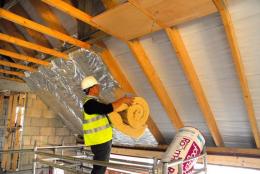Search
Login
Materials for roof insulation than to insulate the roof of a private house - mineral wool, polystyrene foam, hemp, straw and even algae
In an effort to save on heating in the cold season, home owners resort to improving their buildings: studies show that a significant part of the heat received from the heating system simply goes outside due to poor thermal insulation of the building. The culprits of such losses are not only walls, but also not insulated foundations, floors, ceilings and roofs, and an uninsulated roof leads to considerable losses, about a third of the thermal energy can escape from the house through it. So it is necessary for those homeowners who do not want to heat the streets for winter with their own money to think about roof insulation in a wooden house, brick or frame.
Content
- Criteria for choosing a heater video
- Types of heaters that are actively used for roof insulation in modern construction
- Thermal insulators of inorganic origin
- Thermal insulators of organic origin
- Some useful tips from experts
Criteria for choosing a heater

Do-it-yourself insulation of the roof of the house is a very important and crucial step; the process of insulation is not as simple an event as it might seem at first glance. It will require the right choice of insulation, and therefore knowledge of their technical characteristics and installation features, the correct calculation of the thickness of the insulation layer, depending on the material and configuration of the roof.
To begin with, we will decide on what criteria you should make a choice.
First of all, pay attention to the thermal conductivity index. It is measured in W / (mK), it shows how much heat passes per unit time through the unit area of \u200b\u200bthe test material of a given thickness. The thermal conductivity of different samples can vary significantly. That is why it is important to pay attention to heaters with a low coefficient of thermal conductivity, usually they have porous, lightweight materials. Ideal for warming the roof of the house is considered one whose coefficient tends to 0.025 W / (m-C).
When choosing a heater among materials with equal coefficients, preference should be given to one that has a higher indicator of compressive strength and resistance to external loads. Equally important for high-quality insulation is the moisture resistance of the insulation. Ideally, the rate of water absorption should be close to 0. Materials that meet these requirements have a solid uniform structure. You can learn about water-absorbing properties in the technical specifications that manufacturers post on the sites.

Unfortunately, some heaters that fully comply with the previous requirements do not meet the fire safety requirements.
- The flammability markings indicated on them indicate the degree of flammability, moreover, G1 indicates that the material is low combustible, G2 and G3 are moderately combustible, G4 indicates that it is flammable. You should not take risks, materials marked G3 and 4 for roof insulation should not be used.
- Heaters marked D1 are characterized by low smoke generating ability, D2 - moderate, D3 - high, with this indicator, the combustion process will be accompanied by the release of a large amount of smoke with harmful impurities.
- Indicated in the labeling and the ability to spread flame over the surface, the minimum indicator PR1. maximum - PR4, it refers to materials that spread a flame. In appearance, a high-quality insulator should be uniform and even.
The required thickness is calculated in accordance with the rules of SNiP on thermal protection of buildings. In the calculation, it will be necessary to use a coefficient for a specific geographical area.
We pay attention to the service life - it must be long, the quality characteristics should be changed during the operation period.

The insulation should not have a lot of weight, as the weight of the roof can adversely affect its load-bearing structures, as well as other structures of the structure. We pay attention to the environmental friendliness of the heat insulator:
- it should not be dangerous to humans and the environment,
- do not contain chemical harmful impurities, for example, formaldehyde,
- its production should not use freon,
- it should not contain very fine particles or dust.
The belief that heaters made from natural materials are more environmentally friendly is not entirely true, for example, formaldehyde resins are used in the manufacture of mineral wool, and the structure of the material allows them to stand out with increasing ambient temperature.
It will not be enough to be guided solely by technical parameters when choosing a heat insulator - you must definitely take into account the location of the construction.
Types of heaters that are actively used for roof insulation in modern construction
Firstly, it should be noted that all heaters can be divided into those that are made from inorganic raw materials and those based on organic components. And now in more detail we will consider the main advantages and disadvantages of the most popular types of thermal insulation.
Thermal insulators of inorganic origin
mineral wool

A heat insulator characterized by good heat saving, low fire hazard, good sound insulation, vapor permeability, is available in the form of plates or rolls, can have a density of 20 to 200 kg / m3, this variety allows you to choose the type that is needed in a particular situation. Mineral wool insulation - ideal for wooden structures - it provides good thermal insulation and does not deprive wood of its natural ability to breathe.
Among the shortcomings can be noted the ability to absorb moisture, which leads to a sharp loss of heat-saving characteristics, the inability to use uninsulated roofs or facades for insulation, the inability to completely dry the material when moisture gets inside it.
styrofoam
It attracts with a very high heat-saving indicator, it can have a different density, it practically does not absorb moisture, is available in the form of plates of different sizes, has a small weight, is very easy to cut, it is installed quickly.

Negative aspects: a tendency to combustibility and the formation of toxic smoke during combustion, reacts to direct ultraviolet rays, the structure of the heat insulator causes its fragility, therefore, care is required during transportation and installation. Foam insulation of the roof and walls will require equipment in the house supply and exhaust ventilation system - the material does not breathe.
extruded polystyrene foam
It is a type of polystyrene, but consists of closed cells of polystyrene. It is characterized by the inability to absorb moisture, durability, excellent heat-saving characteristics.
But extruded polystyrene foam also does not breathe, it is prone to ignition and the release of toxic substances during combustion.
Owners who want to live in more comfortable and safer conditions can resort to insulating the roof from the inside with the help of materials from organic raw materials.
Thermal insulators of organic origin
natural cork insulation
They are made from crumbs of solid oak bark, or recycled, by processing with hot steam under high pressure and pressing, natural resins are the connecting component. Such a heat insulator is able to pass air well; its surface does not contribute to the development of mold and fungi. The material is flammable, but does not emit toxic substances during combustion. It is suitable for warming the roof of a house, its walls, ceilings, floors.

ecowool
It is made of paper waste paper, synthetic materials are not used as binders in its production, the only impurities in ecowool are flame retardants whose task is to reduce the fire hazard. Ecowool passes air well, but it is also prone to absorb moisture. When installing such a heater, a waterproofing layer must be provided. Ecowool is sensitive to mechanical stresses, the attic insulation is the best option for its use. Rigid cellulose heaters are also available, but binders are used in their manufacture.
straw

Some of the fact that at present the use of such exotic materials as straw may surprise some. Nevertheless, it was straw that for many centuries has been very successfully used as roofing material. The thatched houses were surprisingly cool in summer and warm in winter. Today, straw insulation is manufactured industrially by pressing straw of barley, rye, oats, wheat, with further linking of the obtained blocks with a net or wire. Straw is an excellent air-permeable material; flame retardant treatment is used to improve its fire-fighting qualities.
hemp
Such warming material as hemp is not forgotten today. It serves as a raw material for the manufacture of heat-insulating materials on a natural basis. Such products are produced in the form of plates, rolls, mats or individual fibers with which caulked holes. To reduce the tendency of the material to ignite, it is treated with boron salts. The material is not afraid of mold and fungi, it allows air to pass through, but pressing loads have a detrimental effect on it.

seaweed
Roof insulation can also be done with algae. Before using them, the algae are dried and bulk materials are made from them or pressed into slabs. Since they are saturated with salt, they are not afraid of mold, they do not burn and do not rot. The beams located under the algal ladders are always dry, this significantly lengthens their service life.
Some useful tips from experts
Even though some heaters may not seem so cheap, experts recommend not saving on the purchase of high-quality and environmentally friendly material, because only in this way can the goal of a comfortable atmosphere and temperature in the house, and the health of all households, be achieved. Properly selected materials for roof insulation will help extend the life of all structural elements of the house.
Even the highest quality insulation may not be effective in case of poor-quality installation. Therefore, it is best to trust people with relevant experience to perform roof insulation work. In addition, installation work may vary slightly depending on the material of which the house is made, for example, the insulation of the roof of a frame house and wooden or brick may have some differences.

When choosing a heater with the optimal ratio of cost and quality, remember that in the house where it will be operated, you and the people closest to you will live.





